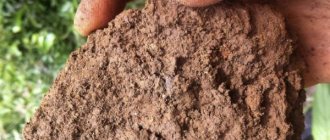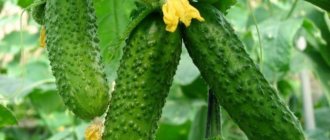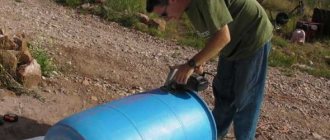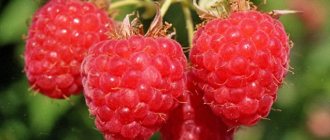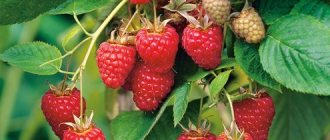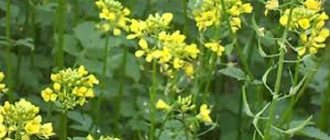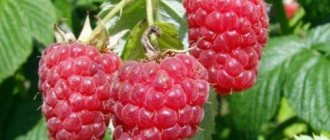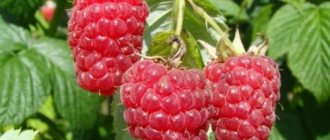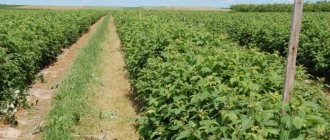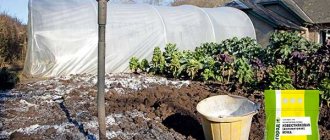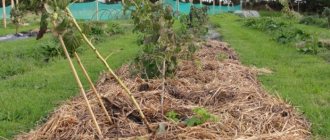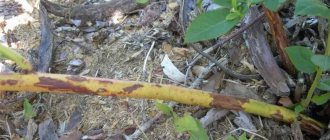How to properly prepare the site and soil for a raspberry garden
One of the most important factors for successfully growing raspberries is the preliminary preparation of a place for a berry garden. The optimal location for the crop will be in the sun or partial shade. The bed must first be dug up. The planting substrate should be permeable and slightly acidic. If the soil is not very fertile, it is advisable to enrich it with compost or other organic matter.
The addition of other substances depends on the composition of the garden soil:
- sandy - to improve it, it should be mixed to a depth of 25 cm with compost and clay, the amount of which should be about 1/3 of the volume of the total soil;
- heavy and dense (clay) - very good for raspberries, but it requires the addition of fine sand;
- peat - in itself very fertile, but with a uniform composition it can be improved with clay (so that the pH is only slightly acidic).
It is important to destroy perennial weeds at the site of the future raspberry garden. This can be done by spraying the grass with herbicides, but for small gardens such a procedure is undesirable, since the active substance is harmful to the human body.
Planting large-fruited raspberries
The soil for large-fruited raspberries is prepared with loose, sandy loam, focusing on the composition of the soil in the designated area. If the soil is heavy, add sand and half-rotted sawdust. And in this case, the raspberry tree needs to be raised slightly above the general soil level (by 10–15 cm) so that in the spring the water outflows faster and the earth warms up.
If the soil on the site is light, it should be “weighted down,” for example, with soil from a compost heap, so that it can retain irrigation moisture. In all cases, it is necessary to add 2 buckets of completely rotted manure per 1 sq.m of raspberry field area. Large-fruited raspberries, like ordinary ones, try to grow into neighboring areas, and to avoid this, you need to dig some kind of limiters into the ground - slate, linoleum, etc. to a depth of 40 cm.
The size of the raspberry tree depends on the planting method you choose. You can create a multi-row plantation, then between the rows you need to leave a distance of 1.8 m, equal to the height of the raspberries, between bushes in a row - 70 cm. Someone grows raspberries in separate bushes with a garter to a stake driven into the center of the bush. The one-line method is more suitable for me, in which the width of the raspberry tree is 70 cm and the length is arbitrary. Since I started talking about “Patricia,” I’ll continue using her example. The seating area for it turned out to be 0.7 × 1.5 m, that is, approximately 1 sq.m. When the shoots began to grow, I did not form 2 separate bushes, but let the new shoots grow freely, removing only thin and weak ones. It is advisable to tie shoots that have reached great heights to a support so that they are not swayed by the wind.
Acidity level, methods of determination
The range of plant tolerance to soil pH is very diverse. Some are very sensitive to even the slightest changes in acidity, others do better in alkaline soils. One thing is certain: soils with extreme reactions are not conducive to growing any plants.
Determining the pH of the soil is not easy, but it is necessary in order to obtain maximum yields and properly use the soil's potential. Electrometric or colorimetric methods can be used for this purpose.
Did you know? Raspberries are a plant that is grown in different climatic zones and has hundreds of different varieties. There are bushes with yellow, black and red fruits, with thorns and without thorns.
A neutral pH of 6.6 to 7.2 is suitable for most plants. Acidic soils have a lower value, and we can talk about a very acidic reaction, starting from a value of 4.5. An alkaline reaction is considered if the acidity is above 7.2; usually such indicators occur when the soil contains carbonate elements.
Tester device
Analysis using a special device is carried out by measuring the difference in indicators (actual and reference). The device consists of a measuring electrode (for immersion in the ground) and a screen on which the result of the measurement is displayed.
Litmus paper
The colorimetric method consists of comparing the color of a soil solution in combination with a suitable indicator on a reference color scale, each color of which has its own meaning. To do this, a handful of soil is mixed with a small amount of water, and litmus paper is dipped into the resulting solution. When the control segment changes color, the color is compared with the acidity palette.
However, this method may not be very accurate, and if clarification is necessary, it is worth contacting a specialized laboratory where they will conduct a chemical analysis of the soil composition.
Natural indicator
Not all plants tolerate even small deviations in pH value from the neutral level. There are also those that thrive only in an acidic or alkaline environment; their presence in the garden bed can help the gardener determine the approximate level of soil acidification.
Plants of indicative acidity include : pansies, field clover, horsetail, juniper, cornflower, field daisies, etc. Acidic soils are also an ideal place for swamps; moss and ferns can often be found on them. You cannot see any of these plants in alkaline soil because they need a high concentration of hydrogen ions. In places where the pH is greater than 7.2, nettle, white nettle, field grass, poppy, spurge and St. John's wort develop well.
Feeding in the planting hole
Planting raspberries in spring is convenient in northern regions where there is a risk of seedlings freezing. Fertilizers for raspberries can be applied directly to the planting hole.
The best combination of organic and mineral nutrition would be:
• humus or compost – 1-2 shovels • superphosphate – 2 tablespoons • wood ash or potassium salt – 2 tablespoons
All components are mixed with soil in the planting hole. Acidic soils must be limed before planting raspberries by adding slaked lime (1 cup) or dolomite flour.
Raspberries planted in well-seasoned soil do not need to be fertilized for the first 2-3 years.
What affects acidity
This indicator is one of the most important soil properties. The value is not constant, it changes under the influence of many different factors that a person can influence. Maintaining a suitable pH of the substrate is very important when growing a particular crop.
From a chemical point of view, the soil reaction involves the separation of water into hydrogen and hydroxide ions. The predominance of hydrogen ions in the soil determines the value of its acidity (pH), the advantage of hydroxyl ions is alkaline. In addition, this level is greatly influenced by the application of mineral fertilizers and heavy rainfall. To a lesser extent, this indicator depends on climate and land use.
The soil reaction is not a constant value; it can fluctuate significantly even during one growing season. These changes are usually caused by heavy rainfall, which is itself slightly acidic and often loaded with sulfur dioxide and other aggravating industrial by-products. The second reason for variable acidity is the activity of plants, which take many minerals from the ground, including those that contain hydroxyl ions. To achieve truly great yields, gardeners must test the soil's response and adjust its levels every few years.
Read what to plant after raspberries in an open ground plot.
The reason that the composition of the earth changes is due to the different content of minerals.
Acidic soils do not contain calcium carbonate and other calcium-containing compounds. They mainly contain hydrogen and aluminum, which have toxic properties. High levels of iron and manganese are also unfavorable for plants. In a low pH environment, the ability to absorb other minerals is significantly reduced, regardless of the intensity of fertilization. It is also favorable for fungi, which quickly begin to develop, feeding mainly on nitrogen, and there is no possibility of binding with other elements at low pH values.
Changing the alkaline reaction should prevent such problems, but will also reduce the solubility and absorption of iron, copper, zinc, boron and phosphorus. Alkaline and neutral soils have a crumbly structure , unlike a substrate with a low level; their structure is subject to the influence of air flow and freely absorbs water.
Basic requirements for autumn planting
In order not to get into trouble and not to ruin everything, pay attention to the following requirements and recommendations:
- It is worth purchasing only annual seedlings;
- Make a supply of water, because you need a lot of it. Moreover, you cannot use ice-cold well water, it has a detrimental effect on the root system;
- It is imperative to check the planting and, if the bush extends freely from the ground, it is worth replanting it;
- Focus on weather conditions and carry out the procedure about a month before possible frosts, because if you don’t do it in time, the young roots will not take root and the bush will freeze in winter, but if you hurry, the plants will begin to grow and the buds will begin to awaken;
- The ideal weather parameters for autumn planting will be a temperature of up to 15 ° C and a humidity of 80%. But the most important thing is how to prepare the ground for planting raspberries.
Soil moisture, control methods
Although the soil is mostly composed of dense particles, there are spaces in the form of pores between the formations containing oxygen and moisture. Ideal soil contains about 50% solids, 25% water and 25% air. Ground that remains wet for long periods of time loses air between formations and becomes compacted.
Did you know? English farmers in the late 19th and early 20th centuries often dug trenches in their gardens and filled them with broken pieces of ceramic tiles to drain wet areas. This drainage completely changed the local ecosystem over time.
Seedlings grow poorly in such substrates, as their roots require oxygen and moisture. Excess moisture causes loss of many beneficial bacteria and organisms that contribute to plant health.
A constantly wet bed can be brought to the desired condition by adding water-absorbing elements. They can be peat, sand or absorbent balls, which can be purchased at gardening stores. Frequent loosening of the bed also contributes to drainage, but when carrying out this procedure, the working person should be careful, since the shallow roots of the shrub are easily damaged by sharp garden tools.
When to mulch raspberries?
Raspberry seedlings must be mulched immediately after planting. To do this, a 10-centimeter layer of sawdust, pine needles or straw is poured under the bushes at a distance of 70 cm.
It is better to mulch adult bushes annually, renewing the covering in spring and autumn.
Before mulching, the soil must be loosened and free from weeds and excess growth. The bushes are watered abundantly and a layer of mulch from the selected material is laid. During the season, material is added if necessary.
Mulching is carried out twice per season. The first time is in the spring, when the night frosts stop. Repeatedly in the fall, before wintering.
On a note! In order for the raspberries to survive the winter better, the bushes need to be watered abundantly before the onset of frost.
Enrichment of soil with fertilizers
After studying the pH of the soil, gardeners can change this value. If the goal is acidification, there are different types of mineral fertilizers, especially those with added sulfur. Composting made from green manure and plant residues produces a similar effect.
Deoxidation usually needs to be done every 4 to 6 years because heavy use gradually lowers the soil's pH level. The most commonly used method for this is liming. On heavy soils the procedure can be repeated even several times. The best time to do this would be after harvest or just before sowing.
Important! Farmers need to know that plants cannot always be planted or sown immediately after liming.
If you plan to plant quickly, it is better to carry out the deoxidation procedure using an aqueous solution of slaked lime. Another, somewhat unconventional, method for deacidification would be the introduction of lime obtained from a sugar factory. This substance is created during the processing of sugar beets and goes to waste. This fertilizer contains about 30% calcium oxide, as well as magnesium, phosphorus, nitrogen and copper, which improve the general condition and productivity of soils. This method is more environmentally friendly, and the structure of defecation lime promotes mixing of the substance with the earth. An additional benefit is that calcium oxide is easily absorbed by plants.
Advantages of autumn planting
Why then do experienced summer residents still choose to plant before the bitter winter? There are several advantages of autumn planting, which boil down to the following:
- A wide selection of planting material, some seedlings are even sold with berries, which is the best advertisement for the variety;
- Quite favorable weather conditions for planting (it is still quite warm, the air and soil are saturated with moisture, frost is still far away, sudden temperature changes are unlikely);
- Young growth does not require special care, all manipulations are postponed until spring, except for preparing the land for planting raspberries in the fall in a timely manner, nothing else is required;
- Young shoots take root better after autumn planting, since there is no unnecessary consumption of nutrients to build up green mass;
- The opportunity to enjoy the first berries next summer tempts many gardeners to plant in the fall;
- In autumn, there are no other activities in the garden, so you can pay special attention to how to prepare the ground for planting raspberries.
Of the disadvantages of this method, perhaps, there is only one - you need to guess the weather correctly so as not to plant the young animals in frost.
Features of preparing sandy and clay soil
Sandy (light) soils are airy and permeable, do not store water and nutrients well, and dry out quickly, so most plants cannot tolerate them. Sandstones are easy to recognize: when squeezed in the palm of your hand, the lump quickly disintegrates and does not leave dirty marks on the skin. You can try to improve sandy soil by adding well-rotted cattle manure, clay and leaf soil, compost or humus. It is preferable to apply in early spring, before the start of the growing season.
Organic matter will fertilize the sand, enriching it with humus and improving its air-water properties. There is no point in fertilizing sandstones with mineral fertilizers, because the nutrients they contain will quickly be washed into deeper layers, which not only does not improve the properties of the substrate, but will also be inaccessible to plants.
Find out how to properly plant raspberries in spring.
Another type of soil is loam, which is rich in minerals, but at the same time very absorbent, compacted, poorly aerated and heavy, so plants will not be able to benefit from the nutrients stored in it. It also warms up slowly, so it stays cold for a long time in the spring. During rainy periods it easily absorbs and retains water for a long time, but during drought it dries out, crumbles and breaks, making it difficult for raspberries to grow.
Wet loam sticks, smears and retains its shape, so you can easily form it into a roller with your hands. However, dry clay crumbles and falls apart. Like sandy soils, clay soil is not suitable for growing plants without proper preparation. Stagnation of water and lack of air contribute to rotting of the roots, and drought causes cracking of the clay and prevents the development of shrubs. However, its quality can be improved by adding loose sand or well-decomposed compost (preferably in the fall).
What kind of soil does raspberry like?
The best soil for planting a raspberry plantation is loamy and sandy loam.
Loamy when dry looks like a coarse powder. Determine that your loamy soil is very durable. You need to slightly moisten the soil and roll it into a “sausage”. When rolled into a ring, the “sausage” should break into components. Unbreakable plastic “donuts” indicate that the soil is heavy and clayey. It is not suitable for planting raspberries, as the roots will quickly dry out from lack of oxygen and waterlogging.
Dry sandstone has the appearance of easily breaking lumps. It does not roll into a rope, but it can be rolled into flimsy balls. If you can’t roll it into a ball, it means the soil is sandy.
The soil for planting raspberries should be well-drained, loose and light, rich in organic matter, fertile for the development of beneficial microorganisms.
Mulching: increasing fertility
Fertile soil can always provide plants with important nutrients and water. Soil fertility and humus content are interrelated; the more organic matter, the greater the yield you can get. Natural organic fertilizers are especially effective. The best measure a gardener can take to make raspberry tree care easier and improve yields is to lay mulch.
This agronomic technique can be used everywhere, from vegetable gardens to berry and flower beds. Mulched plantings are healthier, have fewer weeds, and withstand drought better than bare soil beds. If everything is done correctly, this will allow the gardener to spend less time on watering, weeding, and pest control, and the raspberry bushes will constantly be fed with more and more portions of rotted organic matter.
Mulching rules:
- Mulch is placed on already weeded soil in a thick enough layer to prevent the emergence of new weeds.
- A layer of mulch 10 to 15 cm thick may be required to completely eliminate weeds, although 2 to 3 cm is usually sufficient in shady areas. If the gardener knows that the bed is filled with weed seeds or their perennial roots, a double layer method can be used to prevent weeds from germinating. mulching. Weeding is carried out, then abundant irrigation is carried out, after which newspaper is laid out between the plants (can be in several layers) and a layer of organic matter is placed on top of it.
- Mulching material that retains moisture (such as wood chips) can slow down the heating of the raspberry root layer. Therefore, on remontant raspberry varieties that form berries on the current year’s stems, it is necessary to remove the top layer of organic coating in the spring for faster growth.
There are two main types of mulch: organic and inorganic. Organic includes previously living materials such as shredded leaves, straw, grass, compost, wood chips, bark, sawdust, pine needles and even paper. Inorganic types are black polyethylene and geotextiles (other non-woven materials).
Both types discourage weeds, but organic matter also improves the bed as it gradually decomposes. Inorganic mulches do not break down or enrich the soil, but can warm the substrate and radiate heat during a cold night.
Sapropel
Sapropel is a complex organic and mineral residue formed at the bottom of freshwater lakes from the remains of flora and fauna. The resulting substance contains a large amount of macro and microelements, vitamins, amino acids and other biologically active substances.
We can say that it contains almost all the most useful chemical elements from the periodic table. In addition, sapropel is rich in microflora and beneficial bacteria, so after proper preparation it can be used as a probiotic for plants or soil, which improves crop growth and also increases yield.
Did you know? Agriculture of the ancient Egyptians developed next to the river. The owners of land plots annually fertilized the land with silt, extracted from the bottom during the drying up of the Nile, thanks to which they received high yields.
Sapropel-based fertilizers are most often used as a long-term substance to improve the agrochemical properties of the soil and increase the productivity of plantings. They are unique because, after being added to the soil, they can remain active for up to 5 years.
Purchased soil
If the soil in the garden is rocky and infertile, the situation can be corrected with the help of purchased soil. Along the perimeter where it is planned to plant the raspberry tree, dig a hole (25–30 cm). The resulting wide and shallow hole is filled with soil purchased from gardening farms. It usually has a neutral or slightly acidic pH, essential minerals, and plenty of organic matter. The roots of raspberries lie shallow from the surface, so the depth of the fertile layer will be sufficient for the full growth of the crop.
In the northern regions, when setting up such a raspberry garden, there is no need to dig a pit; it can be successfully replaced by a wooden above-ground box in which fertile soil will be placed. Another advantage of a raised bed is the rapid warming of plant roots. In the south, it is not recommended to create raised beds, since in conditions of high air temperatures the substrate in the box will dry out quickly.
Earthworms
Due to their active life activity taking place in the soil, earthworms are very useful for agriculture: they increase the availability of nutrients, improve drainage and stabilize the soil structure, which helps to increase the productivity of plantings.
Important! Since earthworms do not like soil that is too acidic, alkaline, dry, wet, hot or cold, their presence is a good indicator of soil conditions suitable for plant growth.
Earthworms help improve the fertility of the soil, and their waste is a form of high-carbon fertilizer that feeds vegetation and reduces the stress they receive.
These invertebrates can lose 20% of their weight each day in mucus and casts, so they need moisture to stay alive. Ground cover plants reduce moisture evaporation, so it is advisable to sow the raspberry bed with green manure herbs.
The benefits of having earthworms in the garden bed:
- Good soil structure - an earthworm collects soil particles together into water-resistant formations (casts) that can store moisture without dissipating it. Research has shown that earthworms, which leave casts on the surface of the earth, restore the topsoil.
- Increased yield - Studies in New Zealand and Tasmania found that these invertebrates introduced into perennial grassland resulted in an initial increase in grass growth of 70–80%, with a long-term increase of 25%.
- Increased organic matter - Earthworms feed on soil and dead or decaying plant matter, including straw, leaf litter and dead roots. They are the main agents in mixing surface residues with the soil, making them more accessible to decomposition by soil microorganisms.
Important! It is difficult for earthworms to move in highly compacted soil, so after rainfalls, movement around the garden should be minimal.
Preparing raspberries for winter
In the fall, I rationed them, leaving 12 pieces, cutting out the poorly located ones, trying to keep the distance between the remaining ones as equal as possible. Thus, I got a single small plantation with good lighting and ventilation. Raspberries “Patricia” are quite winter-hardy, withstanding frosts of -30°C, but every winter in the Moscow region the temperature drops below this mark for at least two days, so it is better to bend the shoots. It’s a pleasure to bend “Patricia” - flexible, thornless, not like the thorny raspberries. As I wrote above, during the first winter the shoots broke under the weight of snow and now, taught by bitter experience, I install arcs along the raspberry tree and tie the shoots to them as low as possible.
It is necessary to bend raspberries before the onset of frost, approximately in mid-October. Do not pick off the leaves. In such a small raspberry garden, I bend the shoots towards each other, but you can direct them in one direction, as is more convenient. Over several years of cultivation, the raspberries froze once - during a snowless winter, several buds died on the highest part of the arch of the bent shoot. In the spring, the laterals did not emerge from them, but normal fruiting was observed on the rest of the shoot. After overwintering, when the raspberries are lifted, the shoots crunch and click - do not be alarmed, this is the crunching of the woody bark, which does not affect the further life of the shoot. Help the raspberries straighten and do not tighten the garter. The buds that begin to bloom easily break off, resulting in the loss of 20–30 berries. The apical buds of the “Patricia” raspberry overwinter well, and I never trim the tops, as is sometimes recommended, I tie them to their full height, why give up an additional harvest of berries? But if this is inconvenient for you, trim the tops according to the support.
The design for gartering raspberries “Patricia” is designed in such a way that the shoots can be secured on two parallel bamboo sticks located at a height of 1.8 m (since the wire began to sag quickly under the overall weight of the bushes and berries) with a distance between them 40 cm (more is better, but the metal base to which they are attached did not allow me).
I distribute the shoots evenly, as if in two rows, focusing on which side they grow closer to. In my opinion, this way the raspberries are better illuminated and ventilated, because with so many laterals the bushes form so dense that the berries inside them do not see the sun at all and remain wet for a long time after rain.
Traditional methods: organic fertilizers
Natural homemade fertilizers applied to berry bushes are not only beneficial for plants, but also safe for human health. This is also a good way to use up natural waste from your own garden.
Video: organic fertilizers
Natural homemade organic fertilizers are environmentally friendly and free because they are made from ingredients that the gardener has on hand.
They are rich in various types of nutrients, making them a successful substitute for chemical fertilizers. They have no downsides at all, except perhaps the time spent by the gardener on their preparation. Natural fertilizers that you can prepare yourself:
- wood ash, which prevents soil acidification and increases its pH;
- feeding from eggshells, which is a source of calcium;
- potash fertilizer with banana peel;
- from tea leaves and coffee to acidify the soil;
- liquid green manure from plants (nettles, dandelions, tomato leaves, various herbs);
- fertile compost that increases the humus content.
Many natural fertilizers can be made in a few minutes, although there are also options that take several months to prepare, such as compost.
How to make natural fertilizer:
- Wood ash - if the house has a stove or fireplace that burns wood, you can use the remains to feed shrubs. Ash, as a standalone fertilizer, should be used in moderation as it contains a high concentration of elements such as magnesium, calcium, phosphorus and sodium. In addition, the substance has a high pH and should not be used simultaneously with liming the soil. You can sprinkle the bed with ash, but the best solution is to add this component to compost based on the remains of green plants (due to the nitrogen they contain).
- Green slurry - liquid manure from nettles is one of the best natural fertilizers that you can prepare yourself. In addition to a high concentration of nitrogen, it also contains phosphorus, iron, magnesium and calcium. Nettle suspension is an ideal fertilizer for vegetables (except garlic, onions and legumes) and herbs. It is also loved by berry bushes (raspberries, currants, joshta), roses and perennials. In addition, there is information about the effectiveness of the extract as a natural remedy against aphid attacks. To prepare liquid manure you will need 10 liters of water, 1 kg of fresh nettles without flowers and seeds (or 200 g dried). The plants are placed in a barrel or other container, then filled with water and left to ferment for 2 weeks (when it is cold, fermentation can take up to 4 weeks) in a shady place. It is advisable to stir the contents of the container daily. Before use, prepared liquid manure is diluted with water in a ratio of 1:10.
- Compost is a fertilizer made from organic waste such as grass, twigs, leaves, vegetable peels, eggshells and coffee grounds. It is added to the soil, which helps increase the humus content and retain water and minerals. Soil containing compost is versatile and ideal for growing vegetables, flowers, fruit trees or berry bushes. During preparation, remember that the composted material must be in direct contact with the soil to facilitate access to organic matter for earthworms. After laying, it ripens within several months; the cooking time depends on the air temperature and time of year.
The purpose of preparing a raspberry bed is to give the seedlings a solid foundation for future growth and development, and may include: adding vital minerals and nutrients with fertilizers or organic matter, as well as breaking up and loosening compacted soils.
Inorganic materials for mulching raspberries
In addition to organic matter, various synthetic materials are used for mulching raspberries.
Polyethylene film . Black or transparent film is used mainly to cover raspberries for the winter. This is especially true for northern regions with harsh winters. The film does not allow water and air to pass through, thereby protecting the bushes from the cold.
Using film in the spring you can speed up the warming of the soil and inhibit the growth of weeds. To do this, the film is laid along the bed and secured with heavy objects.
Spunbel . White covering material has high light transmission, prevents the soil from warming up, retains moisture and slightly protects against weeds. Used in summer to protect the soil from overheating.
Spunbond . This modern non-woven material has proven itself well for covering the soil in raspberry fields in autumn and spring.
It allows water and air to pass through well, thereby maintaining good soil aeration. Does not transmit light, which prevents weed germination.
The following materials are also used as mulch: leaf litter, tree bark and wood chips, cardboard and newspapers, agrospan, lutrasil, etc.
